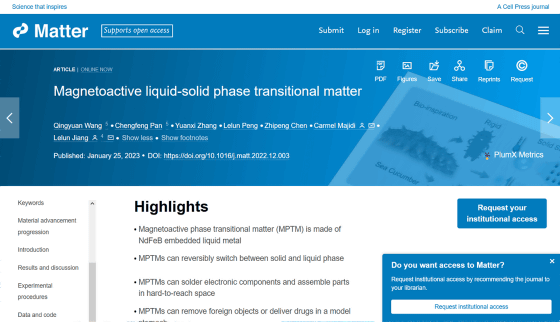A robot that can escape from prison by liquefying the body like Terminator 2's 'T-1000' appears

The futuristic android
Magnetoactive liquid-solid phase transitional matter: Matter
https://doi.org/10.1016/j.matt.2022.12.003

Watch this person-shaped robot liquid and es | EurekAlert!
https://www.eurekalert.org/news-releases/977155
Real-life 'Terminator 2' robot can melt to escape jail, then solidify on command | Live Science
https://www.livescience.com/terminator-2-robot-inspired-by-sea-cucumbers
Scientists Create Shapeshifting Humanoid Robot That Can Liquefy And Reform : ScienceAlert
https://www.sciencealert.com/scientists-create-shapeshifting-humanoid-robot-that-can-liquefy-and-reform
Small robots have potential applications to perform a variety of tasks that are difficult for the human hand or traditional tools, such as repairing small parts and delivering drugs. However, if the material of the robot is hard, it is not optimal for activities in limited or narrow spaces. thing.
Therefore, a research team led by Chengfeng Pan, a mechanical engineering researcher at Sun Yat- sen University in China, turned to sea cucumbers and octopuses that live in the sea to give robots the ability to freely move between liquid and solid states. rice field. Sea cucumbers can change the stiffness of their body tissues to improve their load capacity and avoid physical damage, while octopuses can change the stiffness of their arms for camouflage, object manipulation, and locomotion.
To enable robots to do the same things as these animals, the research team focused on the metal gallium . Gallium has a melting point of 29.8 degrees Celsius, which is lower than the human body temperature, and has the characteristic of becoming a liquid just by holding it in your hand. The research team developed a material called ``Magnetoactive phase transitional matter (MPTM)'' in which magnetic neodymium , boron , and iron are embedded in liquid gallium and solidified. While MPTM has high mechanical strength and excellent controllability, it can be changed from solid to liquid or from liquid to solid depending on temperature.
Carmel Majidi, a member of the research team and a mechanical engineer at Carnegie Mellon University in the United States, said, ``The magnetic particles of MPTM have two roles. 'The magnetic particles also give the robot the ability to move by reacting to magnetic fields.'
When the research team actually tested the mobility and strength of MPTM, it was confirmed that it could use the magnetic field to overcome the fence, split in half and then reunite. In the video below, you can see how a small humanoid robot made of MPTM breaks free from a prison cell, moves out through a gap in the grid, and restores its body.
A humanoid robot developed by a researcher liquefies and escapes from a prison - YouTube
A small robot made of MPTM can be seen on the other side of the grid.

It can be moved using magnets.

Furthermore, by reacting to an alternating magnetic field and causing induction heating, it is possible to melt the body.

I moved it in a liquefied state and escaped the body outside the prison.

When the liquid that came out of the prison was poured into the mold, the body was almost restored to its original state.

In addition, the research team is also demonstrating that an object placed in a model that reproduces the stomach is recovered using MPTM and discharged outside the stomach.
The stomach contains a green object and a square-shaped MPTM.

Magnetic force moves the MPTM to the side of the object and melts it by induction heating.

In a thawed state, it is placed on top of an object and allowed to cool naturally to solidify again.

Objects can be expelled out of the stomach by moving them in a solid state.

By using MPTM, there is a possibility that accidentally swallowed button batteries can be discharged from the body or drugs can be delivered. Also outside the medical field, the research team believes that the robot itself sent during circuit repair can be melted, functioning as a conductor or solder, or used to fix screws in place. However, some improvements must be made to make these features work in the real world. For example, the melting point of pure gallium is below human body temperature, so gallium-based alloys that increase the melting point while maintaining functionality are needed for biomedical purposes.
“Future research needs to further explore how these robots can be used in a biomedical context,” said Majidi. However, more research is needed to delve into how this could actually be used for drug delivery and foreign body removal.'
Related Posts:







